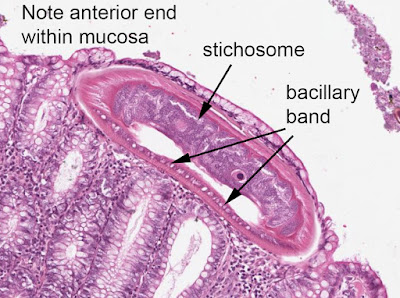It's hard to top Blaine's excellent description of the diagnostic features for this case:
"Trichuris trichiura. If the eggs in utero were not enough, there is also stichocytes and bacillary bands (best seen in the anterior end of the worm within the tissue), polymyarian/coelomyarian musculature, and a strongly nucleated hypodermis. The size and egg morphology rules-out Capillaria philippinensis, which would also be in the intestinal tract and have trichuroid features of stichocytes and bacillary bands."
William Sears also pointed out a helpful feature: "it is telling that the thinner head part is embedded in the tissue and the larger tail is not embedded consistent with whipworm." Besides the eggs, the location in the tissue is one of the key features. Here are some of these diagnostic features:
Eggs with polar plugs (arrows; below):
As many of you may know, the whipworm gets it's name from it's shape - a skinny end and a thicker end, giving the worm a 'whip-like' shape. Unlike what is typically expected, however, the skinny end is anterior - not posterior. When my students find this puzzling, I ask them what they would rather try to do - insert the thin, needle-like end of the worm into the colonic mucosa, or the fat end? I also ask them what makes more sense - having the end with eggs hanging free in the lumen or caught up in the mucosa? This usually helps them conceptualize the worm's morphology, and I think they tend to remember it as well. When it comes to trying to remember the location in the gut, I ask my students what the dreaded complication of whipworm infection is. They always remember that it is rectal prolapse! Once they remember involvement of the rectum, it's easy for them to remember that it's the large bowel rather than the small bowel that is typically involved.
Thanks again to everyone who wrote in, and to my Clinical Microbiology fellow, Dr. Andy Norgan, who came up with the cool programming to rapidly and nearly-seamlessly display whole-slide digital images. For those of you who couldn't get the embedded link to work for you, try this one instead:
https://s3.us-east-2.amazonaws.com/mcr-id-path/slides/BEOEOz_wVUmkRf2L2oG2sg.html





1 comment:
This is a beautiful image
Post a Comment